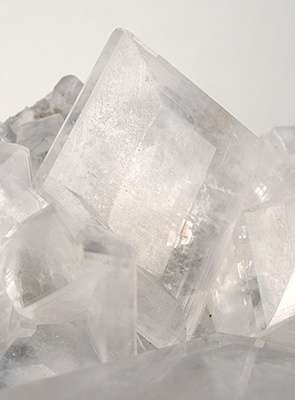Evaporite
Evaporite
Evaporites are a class of sedimentary rocks that form by the evaporation of water, typically seawater, in a closed basin. These rocks are primarily composed of minerals that precipitate from concentrated saline solutions. The most common evaporite minerals include halite (rock salt), gypsum, and anhydrite.
Formation[edit | edit source]
Evaporites form in environments where evaporation exceeds precipitation, leading to the concentration of dissolved salts. This process typically occurs in arid or semi-arid regions where water bodies such as lakes or seas become isolated and begin to evaporate. As the water evaporates, the concentration of dissolved ions increases until they reach saturation and begin to precipitate as solid minerals.
The sequence of mineral precipitation is determined by the solubility of the salts. Generally, the least soluble minerals precipitate first. The typical sequence of precipitation in a marine evaporite setting is:
1. Calcite - Precipitates first, forming limestone. 2. Gypsum - Precipitates as the concentration of calcium and sulfate ions increases. 3. Halite - Commonly known as rock salt, precipitates when sodium and chloride ions reach saturation. 4. Potash and other salts - These include minerals like sylvite and carnallite, which precipitate last.
Types of Evaporite Deposits[edit | edit source]
Evaporite deposits can be classified based on their environment of formation:
- Marine Evaporites: These form in marine settings, such as restricted basins or lagoons, where seawater is the primary source of the dissolved salts.
- Non-marine Evaporites: These form in continental settings, such as saline lakes or playas, where the water source is primarily meteoric.
Economic Importance[edit | edit source]
Evaporites are economically significant for several reasons:
- Salt Production: Halite is a major source of salt for human consumption and industrial use.
- Gypsum: Used in the production of plaster, wallboard, and cement.
- Potash: Important for the production of fertilizers.
Geological Significance[edit | edit source]
Evaporites are important indicators of past climatic conditions and can provide valuable information about the paleoenvironment. They are also significant in the study of basin evolution and can influence the migration and trapping of hydrocarbons.
Challenges in Studying Evaporites[edit | edit source]
Studying evaporites can be challenging due to their solubility and tendency to dissolve or alter during diagenesis. This can complicate the interpretation of the original depositional environment and the reconstruction of past climates.
Also see[edit | edit source]
| Geology | ||||||||||
|---|---|---|---|---|---|---|---|---|---|---|
|
Search WikiMD
Ad.Tired of being Overweight? Try W8MD's physician weight loss program.
Semaglutide (Ozempic / Wegovy and Tirzepatide (Mounjaro / Zepbound) available.
Advertise on WikiMD
|
WikiMD's Wellness Encyclopedia |
| Let Food Be Thy Medicine Medicine Thy Food - Hippocrates |
Translate this page: - East Asian
中文,
日本,
한국어,
South Asian
हिन्दी,
தமிழ்,
తెలుగు,
Urdu,
ಕನ್ನಡ,
Southeast Asian
Indonesian,
Vietnamese,
Thai,
မြန်မာဘာသာ,
বাংলা
European
español,
Deutsch,
français,
Greek,
português do Brasil,
polski,
română,
русский,
Nederlands,
norsk,
svenska,
suomi,
Italian
Middle Eastern & African
عربى,
Turkish,
Persian,
Hebrew,
Afrikaans,
isiZulu,
Kiswahili,
Other
Bulgarian,
Hungarian,
Czech,
Swedish,
മലയാളം,
मराठी,
ਪੰਜਾਬੀ,
ગુજરાતી,
Portuguese,
Ukrainian
Medical Disclaimer: WikiMD is not a substitute for professional medical advice. The information on WikiMD is provided as an information resource only, may be incorrect, outdated or misleading, and is not to be used or relied on for any diagnostic or treatment purposes. Please consult your health care provider before making any healthcare decisions or for guidance about a specific medical condition. WikiMD expressly disclaims responsibility, and shall have no liability, for any damages, loss, injury, or liability whatsoever suffered as a result of your reliance on the information contained in this site. By visiting this site you agree to the foregoing terms and conditions, which may from time to time be changed or supplemented by WikiMD. If you do not agree to the foregoing terms and conditions, you should not enter or use this site. See full disclaimer.
Credits:Most images are courtesy of Wikimedia commons, and templates, categories Wikipedia, licensed under CC BY SA or similar.
Contributors: Prab R. Tumpati, MD




